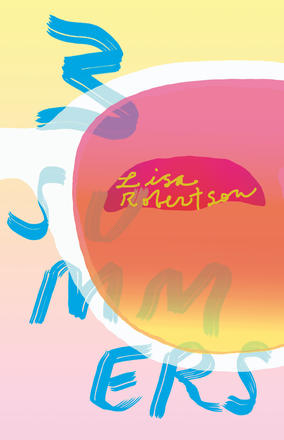 3 Summers 3 Summers By Lisa Robertson Coach House Books, 2016 Contrasting her previous titles, such as Debbie: An Epic or Cinema of the Present, with the newly released 3 Summers, Lisa Robertson—in conversation with Charles Bernstein—suggests that her latest title veers away from the “book as a unit of composition.” Rather than pursuing a particular query for the duration of the book, Robertson implies that 3 Summers is more of a poetic “grab bag.” As a collection of 11 long poems that are each independently gorgeous—and commissioned for diverse, but often fine arts contexts—the idea that these are single poems operating as freestanding agents rings true. At the same time, however, key words, thought processes, creative involvements and concerns repeat, pulse, loop back and insert themselves persistently into the texts, and the collection is further unified by the emotive artwork by Hadley+Maxwell that appears throughout. For me, 3 Summers as a book-length work comes together to articulate a cohesive, poetic feminism: “the total refusal of each existing narrative of femininity” (“The Middle”); it incorporates fleeting rewritings of myths, reappropriations of derogatory terms, and fluid, nonlinear glimpses of form. (It should also be noted that the lines I quote and build my analysis on are culled from a cross section of the book; typically, the lines derive from a reading of 3 Summers as a whole and an enjoyment in linking the common concerns that draw together the distinct poems.) * A major concern throughout 3 Summers is the reversal of the traditional dialectic division between intellect and sensuality. Robertson topples the philosophical entitlement of mental exertion and the scientific prerogative of linearity on its head. She embodies thought and infuses creativity with the rigor of cognition, reversing the established dichotomies, embracing the possibility of a collaboration, an oscillation, between intellect and the senses instead. This book opens with the poetic speaker “lying in the heat wondering about geometry / as the deafening, uninterrupted volume of desire / bellows, roars” (“The Seam”). Immediately, there is not so much a juxtaposition as an inclusion of a highly abstract form of mathematics and the pulse of arousal. “Now it’s time to return to the sex of my thinking” (“The Seam”), Robertson writes, projecting the coexistence of intellectual stimulation with physical pleasure: “I made my muscles into thoughts.” (from “A Coat”) An offshoot of this valorization, or intellectualizing, of sensuality is an ongoing project throughout 3 Summers, which takes the form of an ideology of hormones. Traditionally, hormones go hand in hand with an excess of emotion, the irrational counterpart to logic. The hormonal is often a depreciatory code word to diminish female experience in a vague, offhand way—oh, she has her period, oh, she’s pregnant, oh, she’s menopausal. Robertson channels the uncontainability of hormones or the nondefinitive, fluid context of hormones away from their negative connotations, embracing its ubiquity and allowing it to suffuse her text. The omnipresence of hormones throughout 3 Summers is a fine counterexample to the supposed “grab bag” structure of the book; hormones periodically slip into the poems as a thematic thread running through them. The reader would be hard pressed to escape from hormones as they reside in and progress through the poems, and the promise lingers that “Everything will be a hormone” (“The Seam”): “What I witnessed was But hormones are more intentional than a verbal tic or recurrent allusion. For Robertson, they exceed the boundaries of the letters that spell out the word to become the vessel for poetic expression itself as she celebrates: “The poem is a hormone” (“The Seam”). The reinscription of stereotypically feminine volatility as a form of creative omnipresence is one of the strongest feminist statements I’ve come across in poetry. If hormones serve as a container for poetry, then, at a structural level, poetry points away from rigidity and linearity and towards fluidity, openness, and formlessness as form. “You could say that form is learning,” a process of acquisition (“On Form”). Form is not content, but rather that which forces the content to adjust, that which makes it uncomfortable. If hormones are a factor of disturbance biologically speaking, then in poetry, they can motivate agency and transformation: “is form / a dog as a horse as a deer as a / fish and a bramble a grater rapacious / the second cervical vertebra” (“On Form”). Form is continual transmogrification. Attending a recent public conversation and reading with Johanna Skibsrud hosted by Concordia University’s Writers Read Series, I made a note to myself on my phone, wanting to remember the phrase, “truth procedure, not truth claim.” Although I attributed the words to Alain Badiou, I can’t remember, unfortunately, whether they are a direct quote or Skibsrud’s interpretation of his work. Either way, these words resonate, for me, with Robertson’s writing, for in the process of reversing the hierarchy of intellect and sensuality, she never positions her new mode of thinking as an absolute. While there is a reverent inclusion, or reinvigoration, of hormones, Robertson never crowns hormones as a new ultimate: “there is actually no binary – just the juiciness and joy of form otherwise known as hormones” (“Third Summer”). The instant that one imagines understanding, this semblance of truth melts and a new truth, an ongoing, fluid truth procedure, emerges. * Thematically distinct, but theoretically adjacent to the role of hormones in this book is the preponderance of trees throughout. The Ovidian myth recounts Apollo aggressively pursuing Daphne, a water nymph. As the chase got heated and he was about to overtake her, rape her, she invoked the gods, an act that both saved her and transformed her into a tree. Although this myth is never directly alluded to in 3 Summers, it lingers at the peripheries of my reading experience. Trees, a woman’s relationship to or interaction with trees, the woman as tree, “the / philosophy of the tree” (“Toxins”) combine as another dominant thread that winds through and weaves the poems together:
Trees, in their lush, green vitality, in their gnarled materialization of wisdom, adopt significance, in these poems, as the locus of regeneration and strength. Arboreal aspiration becomes a catalyst for creative expression. Given that in the instant that Daphne shouts out to the gods and voices herself she becomes a tree, it can be argued that utterance as self-activation inspires metamorphosis—metamorphosis into an organism, a tree, that, by definition, never stops growing. Robertson unfurls her speaker. Through a process of verbal photosynthesis, she breathes, speaks and, expressing herself, grows, so that soon her “skin is treebark” (“On Form”) and her words emanate from a sylvan physique: “I had thought In an organic turn of phrase, the poetic speaker has transformed both into a tree—a highly regarded, almost mystical transfiguration—and a dog. In complete contradiction to all cultural programming that condemns calling a woman a dog, a bitch, as one of the lowest possible insults, the dog’s bark resounding gruffly in Robertson’s poem is amplified and enriched to the vibrancy of poetic expression. Barking, here, is the verbalization of tree bark as skin; it is the transformation, the process; it is a primordial mode of expression that doesn’t exit through the throat, but emanates from the entirety of the body’s surface. In this context—reclaiming the figure of the female dog and aligning it with the potency of the tree—it makes complete sense that Robertson strategically positions “the total refusal of each existing narrative of femininity” as “explained to the dog” (“The Middle”). * Robertson autographed my copy of 3 Summers with the words “a tiny draft of coolness” (“The Middle”). Comparing notes after the fact, three or four friends noted that they had received the same inscription. Now that I’ve discovered this line on page 57, I can’t stop wondering whether repeatedly choosing that particular phrase to sign her book was a deliberate authorial nudge, whether the poem on that page includes some kind of specially synthesized message about the book as a whole. Even as I mock my own attempt at manipulating poetry into an exegetic conspiracy theory, I circle the words “in hormonal forest” centred on that same page. Whether Robertson intentionally led me to these words or not (probably not), the obvious confluence of these two concepts—hormones and trees—strengthens my analysis of the collection, at the very least, for myself. * 3 Summers is an incredibly rich text and, of course, I am unable to cover all the material that I had intended to. In particular, I regret not developing on the notion of the feminist goddess; the thematization of the reading process; the triangulation of the collection with the title’s temporality—three summers’ seasonal stasis, recurrence and unrest. Finally, in the spirit of full disclosure and my decidedly subjective stance, Lisa Robertson’s is the book that has moved me most in recent years. Its poetic extremities heighten and sharpen a gentle torsion of nerve endings. It is philosophical, not in the sense of predicating itself on existing theories, but in its honest, necessary articulation and assertion of new, radically contemporary thought. KLARA DU PLESSIS is a poet and critic residing in Montreal. Her chapbook, Wax Lyrical—shortlisted for the bpNichol Chapbook Award—was released from Anstruther Press, 2015, and a full-length collection is forthcoming from Palimpsest Press. Poems have recently appeared in Asymptote, Canthius, CV2, PRISM, Minola Review, among others. She curates the monthly, Montreal-based Resonance Reading Series, and writes reviews and essays for Broken Pencil Magazine, The Montreal Review of Books and The Rusty Toque.
|
Rusty ReviewsMonthly reviews of poetry and fiction. Archives
January 2017
Categories
All
|


 RSS Feed
RSS Feed
